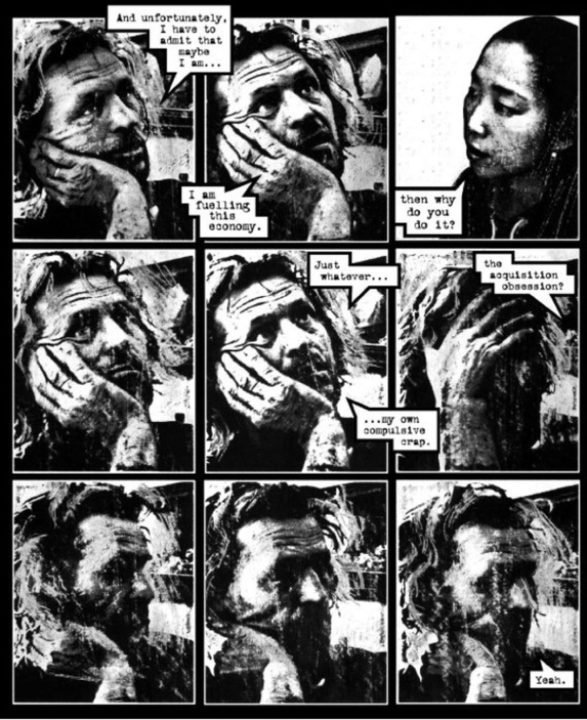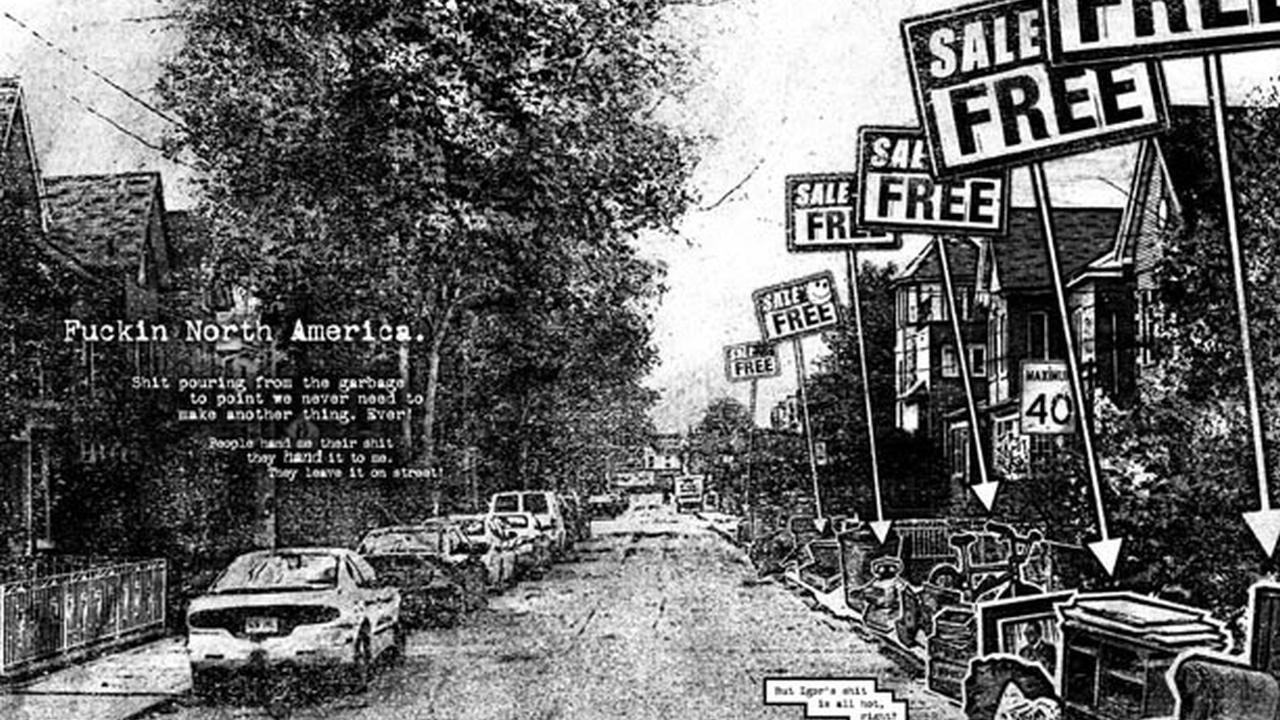Igor Kenk has been dubbed “the world’s most prolific bike thief”. In fact, if your bike was stolen from the streets of Toronto anytime in the past two decades, it most likely ended up in Kenk’s notorious Bike Clinic.
Unfortunately for Kenk, a 2008 raid uncovered 2,865 stolen bicycles and produced 58 criminal charges—but fortunately for Pop Sandbox, Igor Kenk’s sensational 2010 trial coincided with the release of their first-ever title, KENK: A Graphic Portrait. This marked a startling feat in the world of alternative comics—an independent comics publisher who made international headlines, and for their first-ever title, no less. C&G Monthly spoke to the Pop Sandbox team behind KENK’s writing (Richard Poplak), filming and design (Jason Gilmore), product and conception (Alex Jansen) and illustration (Nick Marinkovich).
C&G Monthly: Richard, as a writer who has worked in memoirs and non-fiction, were there any challenges that arose from Jason Gilmore’s KENK documentary footage?
Richard Poplak: Absolutely. The writing process was a question of picking through dozens of hours of material and teasing out a coherent story that has some form of momentum. Structurally, the book draws in comics, prose and film to find itself, which meant that that there isn’t really anyone on earth qualified to write it, including myself.
CGM: What drew you to the story of Igor Kenk?
RP: Very simply, we are defined by characters on the extreme edges of our society. As much as I’d like to write about the upstanding citizens of the world, they can play a little dull. KENK: A Graphic Portrait is as much about what it means to live on the fringes of a tightly regulated society as it is about bike theft. And if I had to define the book in a quick sentence, I’d assert that it’s about a man without the art to implement his ideas, without the moral compass to realize his ideals, pulled out to sea by the power of his compulsion. And don’t worry, the prose in book is nowhere near as purple as that.
CGM: As someone who grew up in South Africa and later came to Canada, how do you regard Kenk’s apparent struggle to balance the Canadian values he lives with now compared to the massive differences of the Slovenian culture he grew up in?

RP: For me, this is the central component of the story. In many respects, the Canadian tale is an immigrant tale: our country is a result of the brutality and ingenuity that comes with immigration. For any newcomer, the process is one of reconciling old values with new values, and this can be a very fraught process. It might be healthy for the broader culture, but it can destroy individual lives. And Igor was unable to reconcile. He imported Slovenia of the eighties wholesale, and slapped that mixture of the hyper-communist and the hyper-capitalist right in the middle of Toronto. He refused to play the game. And it has cost him dearly, but he has maintained an iconoclasm on account of that decision.
CGM: Jason, since you were responsible for video and design, I assume you spent a lot of time with Igor Kenk while filming—what was he like to be around?
Jason Gilmore: Igor was one of the most compelling subjects I’ve ever captured on video. His actions, motions, words and facial expressions were vividly linked to the workings of his mind. He was as unpredictable as he was driven, so a lot of my time with him was spent trying to physically keep up. At times, he would become so consumed by his task at hand—whether it be emptying his truck at the dump or collecting scrap off the street—that he was only half aware that my camera and I were even around.
CGM: Kenk always seems be talking about his point of view. Is this something you encouraged, or was he always eager to share his philosophies with strangers?
JG: Igor loves to talk about his philosophies, so it was always in my best interest to keep quiet and allow him to pontificate with minimal direction. He was passionate about his beliefs, and in his excitement, would usually wind up steering our conversations in completely random directions. In cases like these, we would sometimes have to reign him back in to the subject we were discussing. For the most part, however, we would get the most compelling and poetic answers from him when he was left to speak completely freely.
CGM: Did Kenk ever appear uncomfortable with your filming? He seems to stand completely behind his actions at The Bicycle Clinic but did it ever seem as if you were capturing something he didn’t want recorded?
JG: Igor never had any objections to our filming, and was never uncomfortable on camera. I have shot many subjects who completely freeze up when a camera is around. In Igor’s case, however, I got the sense most of the time that he had completely forgotten we were even filming in the first place.
CGM: Nick, speaking as the illustrator, could you describe the process that would go into creating a single panel or a single page?

Nick Marinkovich: I would start with a page layout provided by Jason. This would include all the source imagery, in the case that I needed to make any tweaks, as there were many times that what looked clear in a colour still simply did not translate well into a hard contrast photocopy. That being said, my first step was always to grayscale the page and really push the contrast. Any snags in the process would always be encountered here, as we were working with low-res video stills that were extremely grainy.
Once eliminating all the colour values, clarity was a huge issue. My methodology to work around this was to stroke out all the characters (or objects of focus) from the backgrounds. This was done very liberally, to create an almost collage-type aesthetic, to really push the lo-fi style reminiscent of Slovenian FV or early Soviet constructivist posters.
Then, in a rather amusing twist, after having taken the time to clean up the page and clarify it as much as possible, I ran it through an old photocopier and destroyed it as much as possible, using razor blades, solvents and simply my hands to crinkle, tear and rough up the page as much as would be allowed. I made a point of not doing any digital post rendering after I had finished “distressing” the page, with the exception of a critical detail having been torn away accidentally. So, what you see in the book is what was left in the end.
CGM: Alex, since you were responsible for conception and production, could you describe the conception of KENK. When was the decision made to begin documenting Igor Kenk?
Alex Jansen: I first met Igor in April 2007 after having already lived in the West Queen West (area) for 3 years; I avoided him for the same reasons as a lot of people. Igor and his shop stood out like a sore thumb in a neighbourhood that had completely changed around him and his reputation preceded him as the stolen bike man. But when I stopped in one night and engaged with him I was really surprised.
Here was an exceptionally bright street philosopher and childhood math prodigy; a former police officer from Slovenia; married to a Juilliard graduate and one of Canada’s top pianists; a radical environmentalist who captures his own shower water to feed his plants; a preacher against western consumption, spouting his own brand of communism, yet all the while acting capitalist in the most vicious way, hoarding countless bicycles, exploiting somewhat of a grey area or loophole in our legislation in regularly buying hot bikes from crackheads.
But the people buying them back weren’t crackheads—it was us. Though I wouldn’t have predicted an arrest of this magnitude, you knew that this man and this neighbourhood were on a collision course. I came back the next day with Jason Gilmore and we began shooting for the next year leading right up to his arrest.
The plan was always to use the raw footage as source material for a new type of graphic novel. By the time Igor was arrested in summer 2008 I was well into my new production and publishing venture (Pop Sandbox), and as it became a larger journalistic story I stepped down on plans to write to bring on Richard Poplak in fall 2008.
CGM: What were the difficulties in getting KENK ready for print and sale? Could you describe the process leading up to its release?

AJ: As much as Igor’s arrest drew a whole new level of awareness to the project, it also created a really ambitious timeline. Competing projects started cropping up and it was important to get the book out while public interest is at a high and as near as possible to Igor’s release from jail. And no one knew our plan was to tell this as a comic book, which isn’t fast to turnaround.
KENK was also the first release for Pop Sandbox, which I’ve structured as both a production and publishing company, so in addition to preparing the actual work I was also paving the road to get it to market, which meant securing distribution, finding printing partners, building a publicity and marketing team, creating media contacts and so forth.
CGM: How is Pop Sandbox handling the success of KENK?
AJ: We’ve been very fortunate with KENK. Igor’s arrest certainly drew a whole new level of awareness to the project and has helped us reach an audience outside of the traditional graphic novel audience.
At this point we’re a month into release and already in to second printing, and we’re currently locking down international plans. We’re working with Craig Small from the Juggernaut on a fully animated film treatment that we hope to have ready in 2011. We’ve posted the first teaser of the animation on KENK.ca and what he’s come up with is nothing short of astounding.
Pop Sandbox is in production on a graphic memoir surrounding the Canadian residential school system with esteemed native artist and filmmaker Nadia McLaren and last fall we won the NFB-TVO Digital Calling Card for an interactive magic realism documentary built around interview with participants who’ve attempted suicide and survived. Both projects will release in 2011.




